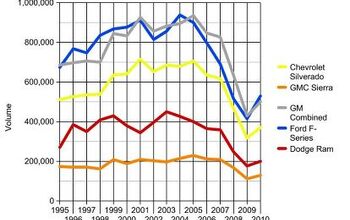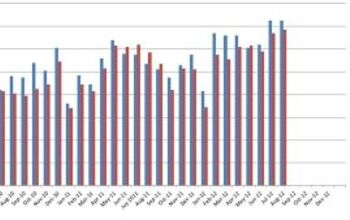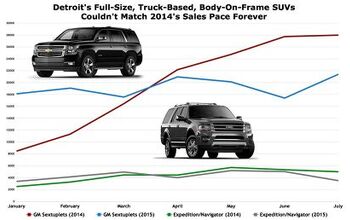Chart Of The Day: Full-Size Sedan Freefall
Recent talk of Chevrolet attempting to convert the 2014 Impala from 75 percent fleet sales to 70 percent retail sales seemed like an improbable figure. Judging the success of any new car is a crapshoot for most of us, but one thing is for sure; the full-size sedan segment as a whole, is declining.
Over the past half decade, the full-size segment as a whole has been in serious decline. The number of product offerings for sale has been cut in half, from 15 to 7. IHS Automotive, an independent research firm, reports that full-size car sales have declined by 42 percent since 2006.
From a peak of 311,128 units in 2007, Impala sales have nearly been cut in half – and the fleet mix numbers suggest that Chevrolet is only selling about 50,000 units at retail. At the other end of the spectrum, the Hyundai Azera is barely moving the needle, consistently selling below 10,000 unts over the past few years. Impala sales will undoubtedly decline with the introduction of the 2014 model – there’s no way that Chevrolet can sustain current volumes if they plan to sell 70 percent of cars to retail customers. But even with sales of 100,000 units, it would still be the segment leader – though the Dodge Charger would be nipping at its heels.
However, an almost-certain reduction in government fleet spending could put a dent in the sales of both models. Sources in D.C. tell us that this could be as much as a 20 percent cutback, or about 100,00-120,000 vehicles. The current Impala, along with the Chrysler LX cars and the Taurus, are darlings of government fleets, and stand to lose the most from this sort of reduction. Meanwhile, the same source tells us that Chrysler is ramping up promotion of its fleet program, with Ram trucks and the LX cars as its main focus.
For many potential large car buyers (whether retail, government or private fleets), a CUV is a much more attractive vehicle, with similar fuel economy and comparable interior volume. For consumers, a CUV is often more appealing to their emotional side, while daily rental fleets can charge more for than a comparable sedan. In other cases, the CUV has a similar footprint but also offers a third row of seats and more cargo room. It’s not a coincidence that some major police departments, like the California Highway Patrol, are opting for the Ford Explorer-based Police Interceptor rather than the Taurus variant.
Speaking of the Taurus, another rumor making the rounds right now is that the Taurus won’t be back after this generation. Poor margins and difficulties during the development process meant that the Taurus has been scrapped part way through the development process, and Ford is content with the Fusion acting as its flagship sedan. If this situation holds true, that leaves Chevrolet and Chrysler as the vanguards of the large American sedan.
Even though rear-drive sedans have fallen out of fashion with most of Detroit, Chrysler seems to have made a business case for the continuation of the rear-drive platform. With Alfa, Chrysler and possibly Maserati sharing the next generation large rear-drive platform, Chrysler and Fiat will have both economies of scale and some high margin luxury vehicles on the same platform.
Previously, Chrysler had little exposure to Europe, Asia and other markets where big engines and a big footprint are seen as negatives. This allowed them to go it alone with the LX chassis and their larger V6 and V8 engines, since their main focus was the United States. Without Fiat, it would have been tough to continue down this road, but now that they can spread the technology across multiple brands and price points, the future of at least one family of full-size sedans is secure.
Furthermore, Chrysler could be in a good position to absorb the rear-drive sedan segment in Australia if GM and Ford walk away from their offerings. The rear-drive Ford Falcon has become a victim of the One Ford policy while the Holden Commodore will apparently adopt the front-drive Epsilon II platform for its next iteration. The 300C and its SRT8 version are gaining a bit of a following in Australia, which is also becoming one of the SRT brand’s hottest markets. Despite the declining sales of the Falcon and Commodore, it would be nothing short of amazing to see both GM and Ford cede that market to a relative upstart that had almost zero presence in Australia just a decade ago.
More by Derek Kreindler
Latest Car Reviews
Read moreLatest Product Reviews
Read moreRecent Comments
- ChristianWimmer This would be pretty cool - if it kept the cool front end of the standard/AMG G-Class models. The front ends of current Mercedes’ EVs just look lame.
- Master Baiter The new Model 3 Performance is actually tempting, in spite of the crappy ergonomics. 0-60 in under 3 seconds, which is faster than a C8 Corvette, plus it has a back seat and two trunks. And comparable in weight to a BMW M3.
- SCE to AUX The Commies have landed.
- Arthur Dailey The longest we have ever kept a car was 13 years for a Kia Rondo. Only ever had to perform routine 'wear and tear' maintenance. Brake jobs, tire replacements, fluids replacements (per mfg specs), battery replacement, etc. All in all it was an entirely positive ownership experience. The worst ownership experiences from oldest to newest were Ford, Chrysler and Hyundai.Neutral regarding GM, Honda, Nissan (two good, one not so good) and VW (3 good and 1 terrible). Experiences with other manufacturers were all too short to objectively comment on.
- MaintenanceCosts Two-speed transfer case and lockable differentials are essential for getting over the curb in Beverly Hills to park on the sidewalk.


































Comments
Join the conversation
I blame record fuel prices, Cafe and today's silly styling trends such as the lackluster LaCrosse with tiny windows, no trunk, absurd curbweight, poor interior space utilization with space stealing center consoles and bloated generic styling. I can think of 20 people right now off the top of my head that would buy a full size Caprice Classic RWD type sedan with a DI V6 engine, 30 highway MPG and true full size interior comfort for around 30 grand. Too bad GM refuses to make such a vehicle available to the public. Yes I know the SS is coming but that is going to be an over priced V8 powered gas swilling Niche car in very limited numbers.
the Impala might fit the EPAs definition of Full Size car, but It just doesn't feel that way to me.